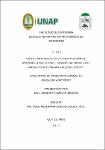| dc.contributor.advisor | Manrique del Águila, Julio Abel | |
| dc.contributor.author | Zumaeta Hidalgo, Raúl Ernesto | |
| dc.date.accessioned | 2021-04-06T02:28:50Z | |
| dc.date.available | 2021-04-06T02:28:50Z | |
| dc.date.issued | 2017 | |
| dc.identifier.uri | https://hdl.handle.net/20.500.12737/7194 | |
| dc.description.abstract | La investigación se realizó con el objetivo de identificar los materiales de la zona que se usan en la construcción rural de sus viviendas en el caserío San Salvador, río Napo, distrito de Mazan. La investigación fue exploratoria y porque no se aplicó ningún elemento que varíe el comportamiento de las variables en estudio. La población fue de 90 familias, con una muestra por conveniencia del 30% que equivale a 25 familias. Para recopilación de la información se utilizó la entrevista abierta.
Se concluye que el tipo predominante de las viviendas es 100% de madera, utilizándose especies como el porotillo, quinilla, huacapú, mohena negra y para las vigas y soleras utilizan pichirina y sacha mangua, por su durabilidad y fácil manejo.
El tipo de piso predominante en las viviendas en el caserío de Salvador, es 100% de madera a una altura de 1.50 m del suelo. El techo de las viviendas está construido en un 84% de crisnejas y un 16% de calamina. Confirmándose la hipótesis formulada: Los materiales que se utilizan en la construcción de la vivienda rural son especies forestales maderables y no maderables que se encuentran cerca de la comunidad en estudio. | es_PE |
| dc.description.abstract | The research was carried out with the objective of identifying the materials of the area that are used in the rural construction of their houses in the San Salvador village, Napo river, Mazan district. The research was exploratory and because no element was applied that varied the behavior of the variables under study. The population consisted of 90 families, with a convenience sample of 30% that is equivalent to 25 families. The open interview was used to collect the information.
It is concluded that the predominant type of houses is 100% wood, using species such as porotillo, quinilla, huacapú, black mohena and for the beams and slabs they use pichirina and sacha mangua, due to their durability and easy handling.
The predominant type of floor in the houses in the Salvador hamlet is 100% wood at a height of 1.50 m from the ground. The roof of the houses is built in 84% of crisnejas and 16% of calamine. Confirming the formulated hypothesis: The materials used in the construction of the rural house are timber and non-timber forest species found near the community under study. | es_PE |
| dc.format | application/pdf | es_PE |
| dc.language.iso | spa | es_PE |
| dc.publisher | Universidad Nacional de la Amazonía Peruana | es_PE |
| dc.rights | info:eu-repo/semantics/openAccess | es_PE |
| dc.rights.uri | https://creativecommons.org/licenses/by/4.0/ | es_PE |
| dc.subject | Materiales de construcción | es_PE |
| dc.subject | Vivienda rural | es_PE |
| dc.subject | Usos | es_PE |
| dc.subject | Arboles maderables | es_PE |
| dc.title | Uso de materiales en la construcción de viviendas rurales en el caserío Salvador – río Napo – distrito Mazan – región Loreto | es_PE |
| dc.type | info:eu-repo/semantics/bachelorThesis | es_PE |
| thesis.degree.discipline | Agronomía | es_PE |
| thesis.degree.grantor | Universidad Nacional de la Amazonía Peruana. Facultad de Agronomía | es_PE |
| thesis.degree.name | Ingeniero(a) Agrónomo | es_PE |
| dc.subject.ocde | http://purl.org/pe-repo/ocde/ford#2.05.05 | es_PE |
| renati.author.dni | 05295326 | |
| renati.advisor.dni | 05221163 | |
| renati.type | http://purl.org/pe-repo/renati/type#tesis | es_PE |
| renati.discipline | 811036 | es_PE |
| renati.level | http://purl.org/pe-repo/renati/level#tituloProfesional | es_PE |
| renati.juror | Flores Malaverry, Jorge Agustín | |
| renati.juror | Chávez Vásquez, Rafael | |
| renati.juror | Pinedo Jiménez, Julio | |
| dc.publisher.country | PE | es_PE |


